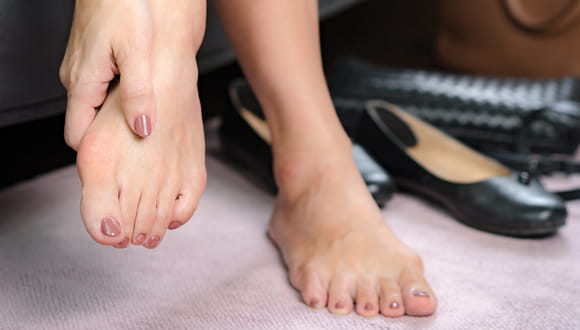Bunion Pain: How to Get Relief & When to Consider Surgery
March 7, 2022 - Katie McCallumYou've noticed a small bump on the outside of your big toe, and it seems to be growing larger as the years go by.
Is it a bunion?
"Bunions are bony, painful protrusions that form on the big toe," says Dr. Andrew Friedmann, a foot and ankle orthopedic surgeon at Houston Methodist. "They're fairly common and often eventually become painful, so if you think you are developing a bunion it's a good idea to be evaluated by a foot doctor."
A doctor's evaluation also is important because bunion pain can progress over time, especially if you're not taking steps to prevent the bunion from worsening.
What does bunion pain feel like?
"A bunion develops slowly over time as pressure on the big toe joint causes the normal structure of the joint to change, shifting it out of alignment," explains Dr. Friedmann. "This results in the big toe leaning toward the second toe and a bony bump forming on the outside of the big toe, causing pain."
The clinical term for this foot condition is hallux valgus, but most people just use the term bunions. These are different from a tailor's bunion, which forms on the pinky toe and is also referred to as a bunionette.
Bunion pain symptoms include:
- A bony bump or protrusion on the outside of the big toe joint
- Pain around the big toe joint, which typically worsens while wearing shoes and walking
- Swelling or redness at the big toe joint
- Callus formation where the big toe rubs against the next toe
- Reduced mobility in big toe
As far as what causes bunions to form, Dr. Friedmann says the exact mechanism is somewhat unclear.
"It's thought that bunions are more likely to occur in people born with a foot problem that increases pressure on the big toe joint, which could be due to being born with abnormal foot structure, having improper walking mechanics or experiencing a foot injury," says Dr. Friedmann.
Additionally, rheumatoid arthritis and wearing tight-fitting or high-heeled shoes are associated with bunions.
"While not thought of as a primary cause of bunions, these are things that may increase your risk of developing bunions if you're already more prone," adds Dr. Friedmann.
How can you get rid of bunion pain?
Whether you have a bunion on one foot or bunions on both feet, they can be painful. It's pain that can worsen over time, but here are 5 steps you can take to lessen it:
Are there other bunion treatment options?
"If at-home remedies don't relieve your bunion pain, let your doctor know," says Dr. Friedmann. "There are other bunion treatment options we can turn to reduce inflammation and achieve better pain relief."
For instance, you may benefit from specialized shoe inserts, called orthotics, or a splint worn at night — both of which work to help better align and support your foot. And, while it can be more time-intensive, physical therapy can help reduce pain and inflammation.
These bunion treatments, as well as the home remedies above, might help slow the worsening of bunions, but, unfortunately, there's no way to prevent bunions completely.
"If nonsurgical bunion treatment options aren't working, it might be a sign that it's time to consider bunion surgery, also called a bunionectomy," adds Dr. Friedmann adds.
When should you consider bunion surgery?
Bunions are initially treated using conservative therapies. But if bunion pain persists despite these treatments and progresses to become very severe or impair mobility, your doctor may recommend surgery.
"There are several different surgical techniques used to correct a bunion, but the goal of bunion surgery is essentially to restore normal positioning and alignment of the big toe joint," explains Dr. Friedmann. "Most people experience significant bunion pain relief after they fully recover from the procedure."
Depending on your specific issue and the surgical technique used to correct it, the recovery time for bunion surgery varies. But it often takes between 6 and 12 weeks — one reason why this procedure is reserved only when pain is severe or mobility is limited.
"It's not a procedure we perform for solely cosmetic reasons," adds Dr. Friedmann. "Additionally, even after bunion surgery, it will be important to make conservative footwear choices — continuing to avoid high heels and narrow shoes."








